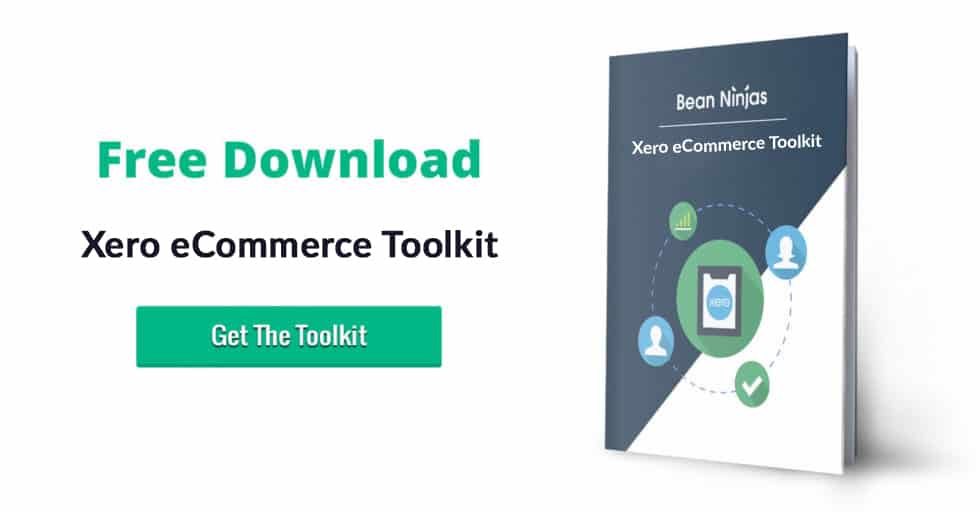Read this detailed guide to building your eCommerce bookkeeping system and processes.
The biggest reason that eCommerce businesses fail is because of a lack of clarity and oversight into how cash is spent.
Luckily, this problem is easier to solve than say a lack of sales. Setting up solid eCommerce bookkeeping systems and processes can help you grow your business and avoid major cash flow problems.
In this guide, we’re sharing everything ecommerce business owners need to know about bookkeeping.
Article Contents
- What is eCommerce bookkeeping?
- What are the key bookkeeping differences for Amazon FBA and Shopify businesses?
- What are the benefits of bookkeeping?
- Set up your cloud accounting tech stack
- Customize your chart of accounts
- Sales tax
- Payroll
- Inventory management and bookkeeping
- What does an eCommerce bookkeeper do?
- How to avoid the most common eCommerce bookkeeping mistakes
- Meet Your eCommerce Growth Partner – Bean Ninjas
What is eCommerce bookkeeping?
eCommerce bookkeeping is the process of recording and keeping track of all financial transactions (including purchases, sales, receipts, and payments) and outflows, list cost of goods sold (COGS), customer acquisition costs, payroll and all related operating expenses, etc.
Having up-to-date books matters because it allows you to know how your business is performing at any given time.
With this, you are likely to experience a bunch of problems, including:
- Cash flow shortages
- Struggling to have funds available for restocking or to meet payroll
- Tax issues and fines
What’s the difference between accounting and bookkeeping?
The easiest way to think about this is that the accountant is like the head chef and the bookkeeper is the sous chef.
The accountant uses the results that the bookkeeper provides to summarize, analyze, and report on the company’s finances.
When you understand the basics of accounting, it can help you have confidence in your finances, stay compliant at tax time, and avoid unnecessary cash flow challenges.
Pro Tip: In our detailed guide to eCommerce accounting, we share a crash course to help eCommerce entrepreneurs set up the necessary systems and processes to take control of their business’s finances.
What are the key bookkeeping differences for Amazon FBA and Shopify businesses?
The underlying bookkeeping principles remain constant regardless of the type of eCommerce business you run.
However, there are some nuances for FBA sellers.Pro Tip: If you are a FBA seller, check out our Amazon accounting guide to understand the ins and outs.
What are the benefits of bookkeeping?
Whether you’re selling products through Shopify, BigCommerce, Magento, Amazon, Etsy, or eBay, here are some of the top benefits for building out solid accounting and bookkeeping systems and processes.
- Get clarity around your business’s finances
- Build a more financially stable, sustainable, and profitable business
- Establish clear growth benchmarks
- Manage cash flow better in lean or uncertain times
- Set up cash flow and inventory forecasts in line with available cash (or assess borrowing needs ahead of time)
- Avoid scary tax letters, fines and penalties
- Make business decisions based on accurate data, not intuition
- Identify trends and spot potential problems early on
- Leverage data to increase customer lifetime value
However, the biggest benefit is to keep your business afloat and put it on the best path for future growth!.
As we mentioned earlier, the number one reason eCommerce businesses go out of business is a lack of cash flow.
If a business doesn’t have sufficient money in their bank account, there’s going to be problems.
Set up your cloud accounting tech stack
This starts with using cloud accounting software that integrates with your ecommerce platform and payment processors. While we are big fans of Xero, there are several accounting tools, including QuickBooks Online, MYOB, Wave, Zoho Books, and Sage Accounting.
Whether you decide to go with Xero, QuickBooks or something else, this will be your central hub for your business finances and key metrics. Having accurate accounting records in your cloud accounting software is crucial for making better financial decisions.
One of the advantages of using Xero is that it integrates with dozens of software that your business might already be using or could use to get more clarity around your numbers.
For example, here is the tech stack that we use with many of our eCommerce clients, like:
- Xero or QuickBooks – your main cloud accounting software
- Gusto – payroll
- A2X – pulling in and reconciling transactions across your sales channels (Pro Tip: Bean Ninjas is one of A2X’s preferred Gold partners. )
- Finale, Unleashed or CIN7 Core – inventory management
- Zamp or TaxValet – sales tax
Customize your chart of accounts
While Xero and QuickBooks both have a default chart of accounts, this isn’t designed for the complexities of eCommerce businesses. Having a bookkeeper can help you set up and manage your chart of accounts.
Your eCommerce chart of accounts (COA) is a structured list of all the financial accounts in the general ledger of the company. It is the foundation of your eCommerce accounting and provides a clear view of every transaction that goes through the business.
And it plays an essential role in sales tracking, expense management, inventory management, sales tax compliance, and taxes.
- Track revenue. A well-organized chart of accounts helps in categorizing these revenues separately for clearer financial analysis. eCommerce businesses can customize their chart of accounts to reflect specific operational needs, such as tracking sales by product line or channel (like Amazon, eBay, etc), which aids in detailed performance analysis.
- Manage expenses. From website development and payment processing fees to advertising costs, staffing, and shipping expenses, your chart of accounts allows these costs to be recorded in their respective categories.
- Keep track of inventory. Your chart of accounts should include accounts for inventory on hand, cost of goods sold (COGS), and any inventory-related expenses. This helps in maintaining accurate inventory records and understanding the cost implications on the business.
- Stay compliant. eCommerce businesses often deal with complex tax scenarios, including sales tax collection from different regions or countries. A chart of accounts helps in properly categorizing tax liabilities and expenses, ensuring compliance and simplifying tax reporting.
- Financial analysis and reporting. A well-structured chart of accounts enables eCommerce businesses to generate and analyze meaningful financial reports in real-time. For instance, a good bookkeeper will ensure you have the following reports updated on a monthly (or sometimes quarterly) basis: Profit and Loss Statement (P&L), Balance Sheet, Cash Flow Statement, and Inventory Forecast. These reports provide insights into sales performance, cost management, profitability, and other key financial metrics, which are essential for informed decision-making.
Sales tax
Registering, collecting, and filing sales tax is complicated for US eCommerce businesses or international businesses that sell in the US.
While eCommerce sellers are only required to collect sales tax in states where they have “sales tax nexus,” there are A LOT of ways that you can wind up with economic nexus in a state, including:
- A location – an office, warehouse, fulfillment center, store, or other physical place of business
- Personnel – an owner, employee, contractor, salesperson, installer, or other person doing work for your business
- Inventory – Most states consider storing inventory in the state to cause nexus even if you have no other place of business or personnel
- Affiliates – Someone who advertises your products in exchange for a cut of the profits creates nexus in many states
- A drop shipping relationship – If you have a 3rd party ship to your buyers, you may create nexus
- Selling products at a tradeshow or other event – Some states consider you to have nexus even if you only sell there temporarily
- Economic nexus – Exceeding the online sales or transactions amount set by the state
- Advertising nexus– This is a lesser-known one but many states will consider you to have nexus in a state if you run direct mail campaigns, have billboards, or geo-targeted Google or Facebook ads.
Not to mention, you must have a permit before you can even collect sales tax from customers.
And sales tax collection and filing can get even more complicated if you sell both physical and digital products or are on multiple third-party marketplaces.
That’s why we recommend using automated sales tax software like Zamp if you are a newer business or a sales tax advisor, like TaxValet, to help you with this process.
Related Reading: A Detailed Guide to US Sales Tax Compliance
Payroll
If you have any employees, payroll management is an essential bookkeeping function. This includes not only the payment of wages or salaries but also the management of benefits, tax withholdings, employment laws and other deductions.
Here are all of the things you need to consider:
- Implementing payroll systems. This involves selecting appropriate payroll software and making sure it is properly integrated with your accounting tech stack.
- Ensuring accuracy and compliance. This includes staying updated with changes in tax laws and employment legislation and making sure the company is compliant.
- Managing payroll expenses. The bookkeeper records and manages payroll expenses, ensuring they are correctly categorized and reflected in the company’s financial statements.
- Liaising with HR. In many eCommerce settings, the bookkeeper works closely with human resources to manage payroll-related issues and may also serve as a point of contact for employees for payroll inquiries.
- Generate reports. Your bookkeeper is responsible for generating payroll reports that are essential for financial analysis and decision-making. These reports can provide insights into labor costs, departmental expenses, and overall financial health.
- Handling tax documentation and filing. From W-2s and 1099s to filing end-of-year documents, your bookkeeper ensures that all payroll-related tax filings are accurate and submitted on time.
Inventory management and bookkeeping
Effective inventory management is crucial for ensuring that products are available for sale without overstocking, which can tie up capital unnecessarily.
Bookkeeping plays a big role in all of this, including:
- Recording inventory transactions. Your bookkeeper records all transactions related to inventory, including purchases, sales, returns, and write-offs. This ensures you have accurate financial records.
- Calculating Cost of Goods Sold (COGS). You need to calculate cost of sales, or COGS, to determine the gross profit and understand the true cost of inventory sold.
- Inventory valuation. Your bookkeeper can assist in valuing inventory, which can be done using various methods like FIFO (First-In, First-Out) or LIFO (Last-In, First-Out), depending on the business model and accounting practices.
- Budgeting and financial planning. Your bookkeeper can help in budgeting for inventory purchases and provide data for financial planning. This ensures that the business has enough capital for inventory without overextending financially.
- Tax compliance. Accurate inventory records are crucial for tax purposes, and a bookkeeper ensures that inventory is reported correctly in tax filings.
- Loss prevention. By maintaining accurate inventory records, a bookkeeper helps in identifying discrepancies, which can be indicative of issues like theft, damage, or administrative errors.
What does an eCommerce bookkeeper do?
Managing your eCommerce books becomes easier once you and your bookkeeper have the right tech stack in place and stick to a solid process.
A great bookkeeper ensures that your financial records are up to date, transactions are properly categorized, and sends financial reports in a timely fashion.
The average hourly rate for a bookkeeper ranges from $10 – $40 USD / per hour.
When it comes to hiring a bookkeeper, you can hire one in-house as a full-time employee, use a freelance bookkeeper, or work with a third-party ecommerce specialist accounting firm, like Bean Ninjas.
For example, Bean Ninjas is a certified A2X Gold Partner and won Xero’s Bookkeeping Partner of the Year back in 2019. In addition to having years of experience working with Amazon and eCommerce entrepreneurs, dialed-in bookkeeping processes, and exceptional customer support, we also know the ins and out of the Xero platform and have relationships with people inside Xero that we can leverage for support. This is something you’d be hard-pressed to find if you hire an in-house bookkeeper in your city.
Pro Tip: If you have never hired a bookkeeper before, it can be an overwhelming experience, especially if you don’t have a financial background. Our detailed guide to hiring bookkeepers can be a great resource.
Weekly bookkeeping tasks
There are bookkeeping tasks that you should do weekly, monthly, and quarterly.
On a weekly basis, it is about keeping up to date on your transaction processing and reviewing for necessary adjustments to your chart of accounts. This ensures that you are always looking at the most accurate financial data, which is crucial for making any decisions that can affect your business’ growth path.
In addition, you’ll also want to be looking at key financial reports like your P&L statement, balance sheet, and cash flow summary statement.
Pro Tip: You simplify your financial reporting by creating a financial performance dashboard.
Monthly bookkeeping tasks
On a biweekly or monthly basis, this is where both cash flow and inventory management are crucial.
Here are some things you can do, including:
- Month-end close process
- Set up cash flow forecasts
- Use inventory management software to manage and forecast inventory.
Quarterly bookkeeping tasks
On a quarterly basis, this is where you should be reviewing your business’s finances from the previous quarters, setting new growth goals, and making sure your reporting is in order.
Pro Tip: Spending a little time once a month or a quarter to ensure your taxes are in order can also avoid added stress and compliance issues at tax time. To avoid compliance or added stress at tax time.
How to avoid the most common eCommerce bookkeeping mistakes
In our experience working with eCommerce businesses, here is a quick rundown of some common eCommerce bookkeeping mistakes.
- Sticking with cash accounting. Opting for cash basis accounting over accrual accounting often results in a distorted financial perspective, especially for eCommerce businesses experiencing rapid growth.
- Going the DIY Excel route. Relying on manual spreadsheets, rather than adopting cloud accounting software and inventory management software tends to lead to errors and missing information.
- Not customizing your chart of accounts. The practice of using a standard or incorrect chart of accounts in software like Xero or QuickBooks typically causes inaccuracies in financial reporting.
- Misunderstanding Amazon fees. A common error is misinterpreting Amazon fees and net sales, which frequently leads to an overestimation of profits and inaccuracies in inventory and cash flow estimates.
- No inventory accounting process. Failing to implement a robust inventory accounting process usually results in incorrect inventory valuation and an overstatement of profits for specific products.
- Not calculating landed costs properly. Incorrectly calculating landed costs, particularly by omitting expenses like customs and shipping often leads to undervaluing inventory and overstating profits.
- Messy bookkeeping process. Neglecting regular bookkeeping and financial review sessions can cause a range of financial problems, incur penalties, and threaten the long-term financial health of your eCommerce business.
Meet Your eCommerce Growth Partner – Bean Ninjas
Want help staying on top of your books with ecommerce bookkeeping services? Schedule a free call to improve your cash flow and get more confident in your numbers.
If you’re still not sure which ecommerce accounting software is right for you, read our full guide: How to Choose the Right Accounting Software for your Business.
And, download our Xero eCommerce Business Toolkit.





